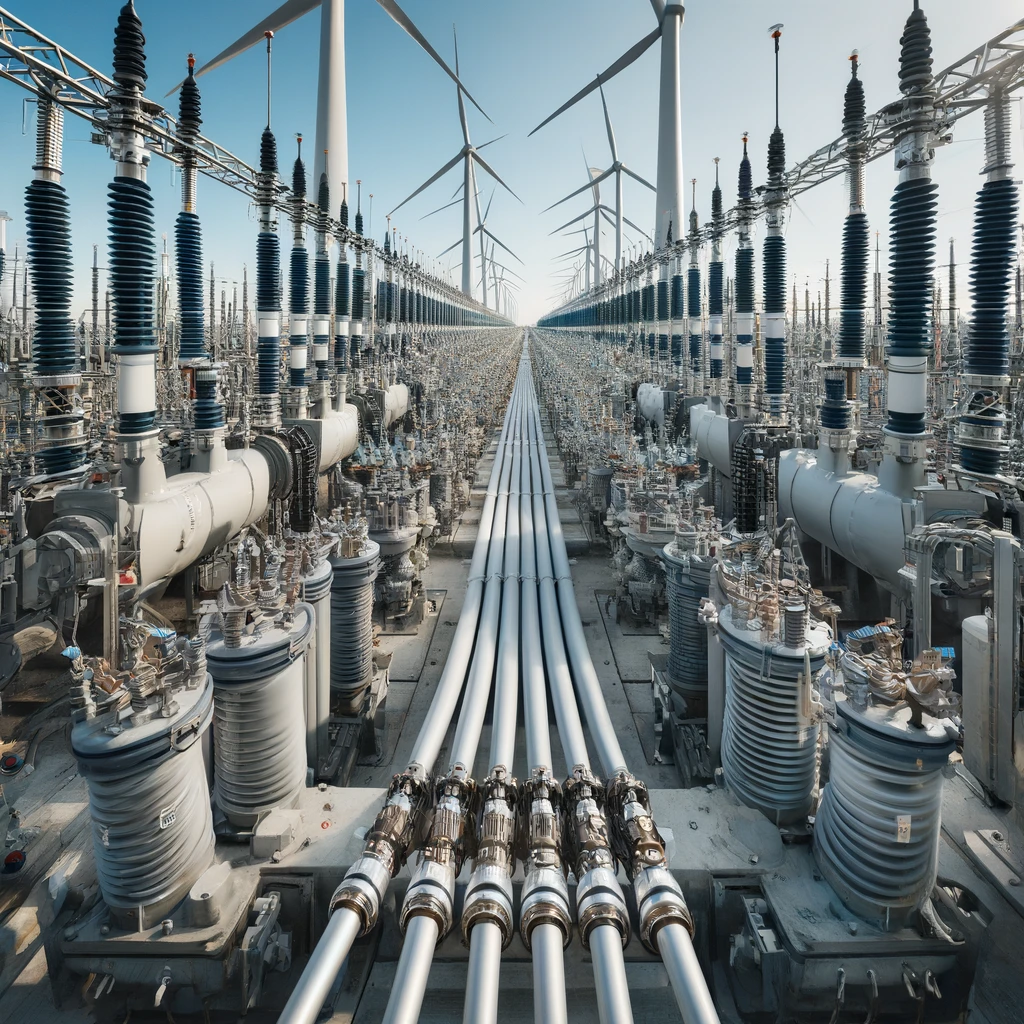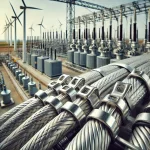Wind farms are an essential part of the renewable energy landscape, providing clean electricity to millions of homes and businesses. However, the infrastructure that supports wind farms, particularly substations, operates in challenging environments. Substations are exposed to harsh weather conditions and must reliably manage the complex electrical cabling that keeps the system running efficiently. Stainless steel ties provide a robust solution for securing cabling in these demanding conditions, offering durability, corrosion resistance, and ease of use.
In this post, we will explore how stainless steel cable ties play a critical role in wind farm substation cabling, why they are the best choice for these high-stress environments, and how their unique properties ensure long-lasting performance. Let’s dive into the specific applications and benefits that stainless steel ties bring to wind farm substations.
The Importance of Cable Management in Wind Farms
In any wind farm, the substation is the heart of electrical distribution, controlling and regulating the flow of power from turbines to the grid. Proper cable management within the substation is vital to ensure smooth and efficient operations. With hundreds of cables managing high-voltage power, the need for secure and organized cabling becomes even more critical.
Stainless steel ties provide the strength and reliability needed to ensure that cables are properly secured, especially in outdoor environments. Wind farm substations face unique challenges such as exposure to saltwater, high winds, extreme temperatures, and UV rays, all of which can degrade traditional fastening solutions. Stainless steel ties offer a solution that can withstand these conditions, ensuring that cables remain securely in place, reducing the risk of downtime and costly repairs.
Corrosion Resistance in Harsh Environments

One of the key reasons stainless steel ties are used in wind farm substation cabling is their exceptional corrosion resistance. Wind farms are often located in coastal areas or other environments where exposure to saltwater or moisture is common. Traditional cable ties made from plastic or lower-grade metals can quickly corrode, leading to cable slippage or failure over time.
Stainless steel, particularly 316-grade, provides the best defense against corrosion in these environments. Its high resistance to rust and saltwater ensures that cables remain securely fastened, even after years of exposure to the elements. This is crucial for wind farms, where equipment must last for decades with minimal maintenance. By using stainless steel ties, operators can reduce the risk of corrosion-related issues, ensuring that substation cables remain intact and fully functional.
Heat and UV Resistance
Wind farms experience a wide range of temperatures, from blistering summer heat to freezing winter conditions. These temperature extremes cause some materials to expand, contract, or even break down over time. Stainless steel ties, however, withstand significant temperature variations without losing strength or integrity.
Wind farm substations often endure direct sunlight, which can degrade some materials over time. Plastics, for example, become brittle under UV rays, increasing the risk of failure. Stainless steel ties resist UV damage, ensuring they won’t weaken due to prolonged sun exposure. This makes them ideal for outdoor wind farm applications where durability is crucial.
Applications of Stainless Steel Ties in Wind Farm Substations
Stainless steel ties are incredibly versatile, making them a valuable tool for securing various components within wind farm substations. From bundling high-voltage cables to organizing smaller wire harnesses, stainless steel ties provide a reliable solution for managing all types of electrical cabling. Below, we explore some specific applications of these ties in wind farm substation environments.
Securing High-Voltage Power Cables
High-voltage cables are the lifeblood of any wind farm, transferring electricity generated by turbines to the grid. These cables are often large, heavy, and subject to significant stress from both electrical currents and environmental factors. Stainless steel zip ties provide the strength and security needed to keep these cables securely fastened, even in the face of strong winds, vibrations, and temperature fluctuations.
In wind farm substations, the ties can be used to bundle and organize high-voltage cables, reducing the risk of damage caused by cable movement or friction. The self-locking mechanism of these ties ensures a secure and reliable hold, while their corrosion-resistant properties make them ideal for long-term use in outdoor settings.
Organizing Control and Data Cables
While high-voltage cables are the most visible part of wind farm substations, control and data cables also play a critical role in ensuring efficient operations. These cables transmit vital information about the performance and status of the wind turbines, enabling operators to monitor and manage the system remotely.
Steel ties offer a neat and efficient way to bundle and organize these smaller cables, keeping them protected from environmental factors and preventing them from becoming tangled or damaged. By using steel ties, operators can ensure that control and data cables remain securely in place, reducing the likelihood of communication failures or other issues that could disrupt operations.
Benefits of Stainless Steel Ties in Wind Farm Substations
The benefits of steel ties for wind farm substation cabling go beyond just corrosion resistance and durability. They also offer ease of installation, long-term reliability, and a cost-effective solution for cable management in challenging environments. Below, we explore some of the key advantages that stainless steel ties bring to wind farm applications.
Ease of Installation and Maintenance
One of the most significant advantages of steel ties is their ease of installation. With their self-locking mechanism, these ties can be quickly and securely fastened without the need for additional tools or complex procedures. This not only speeds up the installation process but also reduces the risk of errors that could compromise the security of the cabling.
In addition, tese ties require minimal maintenance. Once installed, they can remain in place for years without the need for adjustment or replacement, even in harsh environments. This reduces the overall cost of maintenance and ensures that wind farm substations can continue to operate smoothly with minimal downtime.
Long-Term Reliability
Wind farms are designed to operate for decades, and the infrastructure that supports them must be equally long-lasting. Stainless steel ties provide the long-term reliability needed to ensure that substation cabling remains secure and operational over the lifetime of the wind farm. Their resistance to corrosion, heat, UV rays, and mechanical stress ensures that they can withstand even the harshest conditions, making them a cost-effective and reliable choice for wind farm operators.
Choosing the Right Stainless Steel Ties for Wind Farm Substations
When selecting stainless steel ties for wind farm substations, it's essential to choose the right type and size for the specific application. Factors such as the grade of stainless steel, the length and width of the tie, and the specific environmental conditions must all be considered to ensure optimal performance.
316-Grade Stainless Steel for Corrosion Resistance
For most wind farm substation applications, 316-grade stainless steel ties offer the best balance of strength and corrosion resistance. This grade of stainless steel contains molybdenum, which enhances its ability to withstand exposure to saltwater, chemicals, and other corrosive substances. In coastal wind farms, where salt spray and moisture are constant challenges, 316-grade stainless steel is the preferred choice for long-lasting performance.
Choosing the Right Size and Length
In addition to the material, it's important to choose the right size and length of stainless steel ties for each application. Larger, heavier cables may require longer and wider ties to ensure a secure hold, while smaller control and data cables can be secured with shorter, narrower ties. Ensuring that the tie is the appropriate size for the cable will help prevent slippage or failure, ensuring that the substation cabling remains secure and organized.
Wrapping Up: Why Stainless Steel Ties Are Essential for Wind Farm Substations
Stainless steel cable ties are an indispensable tool for managing cabling in wind farm substations. Their corrosion resistance, heat tolerance, and UV stability make them ideal for use in harsh environments, while their strength and durability ensure long-term performance. Whether used to secure high-voltage power cables or organize control and data lines, stainless steel ties provide a reliable and efficient solution for wind farm operators.
For more insights and tips on cable ties and other related products, explore cabletiesunlimited.com and follow us on our social media communities on Facebook and Instagram!

